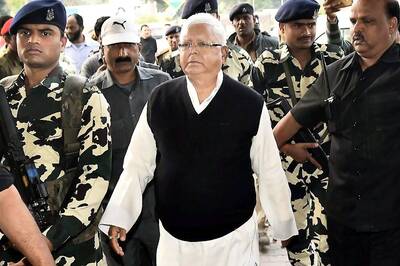
views
Ayodhya’s infamous Ram Janmabhoomi-Babri Masjid conflict, a land dispute of religiosity, has found itself at the end of a journey spanning centuries on the momentous day of November 9, 2019. Today, our fear of history repeating travesties that occurred 27 years ago have been squandered with brotherhood, love and the unanimous verdict of the Supreme Court.
The three way tug-of-war for title of the land, for recognition, for the right to worship, for the rewriting of history, had the nation on edge with bated breath. The even-handed verdict has provided relief to all three parties: Ram Lalla, Sunni Waqf Board and Nirmohi Akhara.
The 2.77 acre land of Ram Janmabhoomi is wholly to be used for the construction of Ram Temple under the purview of a Trust selected by the central government. The Sunni Waqf board will be allotted 5 acres of prominent land within Ayodhya to build a mosque. It should be delivered by the central government within three months. The Supreme Court’s interference and usage of Article 142 states that a trust issued by the central government for the management of Ram Janmabhoomi will have some members of the Nirmohi Akhara.
The Ram Janmabhoomi land belongs to the government of India as per the revenue records, which has brought no objection by all parties as none contested private right to the land, nor could they prove it. This ruling has nullified the 2010 High Court verdict of a three way division of Ram Janmabhoomi, which Chief Justice of India Ranjan Gogoi said should not have ever happened. The Supreme Court’s verdict is not one of right or wrong, it is not based on religion, it is based on justice.
To understand the pulse of the nation, we must understand our history. Until the recent past, Ayodhya was fabled as the largest city of India under the rule of Lord Ram, and one of the most spectacular visions to behold. In Ayodhya, we have ‘Ram Janmabhoomi’, the birthplace of Hindu deity Lord Ram. Of great religious value to Hindus, it is a place where Manu, the progenitor of man, began his lineage and Ram his descendant, the seventh incarnation of Lord Vishnu, was born.
The great saga of Ramayana depicts Ram with great reverence as a ‘Maryada Purushottam’. He was an individual who followed the rule of human law to such a degree that he was more than a king to his people, he was the reincarnation of Vishnu, he was a God. With time, his venerated kingdom was buried under centuries of conquests, chipped away from our memories until Ram, Ram Janmabhoomi and his Ayodhya became mythical folklore.
Yet, through sheer resilience of believers, the excerpts from Hindu scriptures and historical records were extrapolated by theologists and historians alike, the location of Ram Janmabhoomi was pinpointed as ‘Babri Masjid’, a mosque created under the rule of Babur.
Several notations in Babur’s diary, titled ‘Babur Nama’, show he was in/around Ayodhya during the time of its destruction. It was said that during Babur’s reign, he had toppled a temple of great size and majesty and constructed a mosque atop the ruins.
Through archaeological excavations that took place in 1975-1980 by the Archaeological Survey of India team led by Professor BB Lal, we gathered evidence of a Hindu building lying underneath Babri Masjid and some parts of the building inculcated into the structure of the masjid. Most of the evidence was deemed circumstantial by the Supreme Court, but it was enough to claim the land as Ram Janmabhoomi.
The Supreme Court stated that Babri Masjid was created upon a demolished building of Hindu origin which was a strong base for the verdict. The panel of judges also disclosed in the beginning of their half hour reading of the verdict that all sides believe the disputed land is indeed the birthplace of Lord Ram.
Some individuals may disagree with the verdict, which is their prerogative, but when seen with a rational mind and with sensitivity we can notice the great mental acumen that was required to come to such a harmonious judgment. The Supreme Court has upheld the values of the Constitution of India providing each religious group equal treatment, and promoting secularism which is the very fabric of our democracy.
The disputed land is 2.77 acres, yet our Muslim brethren have been given land that is almost double the size to build a mosque which they do not need to share. The interference with Article 142 provides every Hindu group and sect the opportunity to work together in building the Ram Temple peacefully, avoiding further disputes.
Understanding the gravity of the situation is a must while understanding the direction of the verdict, the Supreme Court ruling has been a difficult one but one of great nuance. On one hand, we have a place that is claimed as the birth right of a Hindu deity, on the other hand we have a land conquered by a King where a mosque is built. To which does the scale tip? Avoiding past reoccurrences, taking into consideration the sentiments of the nation, and to allot all religious parties, a place of worship they can call their own, is indeed a unanimous decision welcomed by the nation.
Now we have a place that we can call Ram Janmabhoomi, this important information is no longer a part of mythology. It is a part of our nation's history. The power now lies with the people to do justice not only to the land, or to their religion, but to do justice to our neighbours. Centuries of war and desecration have caused much anguish to which there is no end, now we should come together as one and beseech the religiously passionate people of our country to be overcome with the passion of love and tolerance. Now that the verdict has been made, we should move forward together as today marks the beginning of a 'New India’, where the past and the present collectively build a strong base for the ‘Dawn of New India'.
(The author is an entrepreneur, columnist and the co-convenor of Group of Intellectuals and Academicians which advocates for the rights of women in India. Views are personal)

















Comments
0 comment